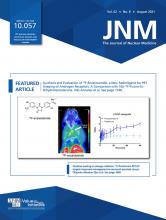The recently published results of the VISION trial (1) represent the culmination of translational research efforts that started in the 1980s and early 1990s with the discovery of the prostate-specific membrane antigen (PSMA) (2). Because of favorable biodistribution and tissue expression, PSMA was soon recognized as a promising molecular imaging target. The first Food and Drug Administration–approved PSMA-targeted ligand was 111In-capromab pendetide, a mouse monoclonal antibody that binds to the intracellular domain of PSMA. It failed in the clinic because of low sensitivity and specificity. Subsequently, the Weill Cornell group developed an antibody (J591) that binds to the extracellular domain of PSMA and provided the first insights into the therapeutic potential of targeting PSMA (3,4). Small-molecule inhibitors of PSMA were pioneered by Pomper’s group (5) and were subsequently modified and successfully translated by the Heidelberg group (6,7), among others.
Johannes Czernin
A German retrospective multicenter trial (8) provided the impetus to conduct prospective studies determining the therapeutic efficacy of 177Lu-PSMA617. To date, the results of 3 of these studies from Australia and the United States have been published in full (9–12). All suggested therapeutic effectiveness when a 50% reduction in serum PSA levels was used as a surrogate intermediate endpoint biomarker. Another recent pivotal randomized trial found that 177Lu-PSMA was superior to cabazitaxel in patients with advanced castration-resistant prostate cancer (11).
On June 3, the results of the international randomized, multicenter VISION trial were presented during a meeting of the American Society of Clinical Oncology and provided the first hard evidence for a significant improved progression-free (−60%) and overall survival (−38%) in late-stage prostate cancer patients who were treated with 177Lu-PSMA when compared with the standard of care (1).
This success is a tribute to the scientific talents and achievements of preclinical and clinical nuclear medicine scientists. Many will take credit, but it should be very clear: this one is on nuclear medicine (and biology) primarily; it is a testament to what nuclear medicine scientists can accomplish with their unique basic biology, radiochemistry, physics, and instrumentation competence. It also provides evidence for a powerful emerging translational and clinical research infrastructure with a rapidly evolving capability to conduct appropriate prospective clinical trials that are designed in close collaboration with leaders from oncology and urooncology.
Fendler et al. have recently commented on the impact of the VISION results on the practice of nuclear medicine and the clinical expansion of theranostics (13). We now need to prepare for a large number of prostate cancer patients who will benefit from our services. We must also continue and intensify prospective research to determine the best placement of radioligand therapy throughout the various progressive stages of prostate cancer. Finally, we need to decipher treatment resistance mechanisms to identify and exploit cancer liabilities with rational combination therapies to further improve patient outcomes.
But for now, let’s celebrate the successful clinical translation of PSMA-targeted theranostics, which is among the greatest success stories in the history of nuclear medicine.
- © 2021 by the Society of Nuclear Medicine and Molecular Imaging.








